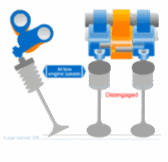
As the engine turns, the camshafts turn in relation and they push the valves open for the cylinder.
VTEC is change both the duration and lift of the valves as engine speeds change by using different cam profiles.
During low-RPM operation, the valvetrain works normally; ie. the smaller profiles push the smaller rocker arms which then push open the valves. But when the engine enters its higher-RPM range, a hydraulic system pushes a pin that connects the VTEC rocker with the two rockers beside it.
When that happens, the larger VTEC cam profile pushes all three rockers even further due to the fact that the VTEC rocker arm is now connected to two non-VTEC rocker arms. When the larger cam profile isn’t needed anymore, the pin disengages and unconnects the three rocker arms, reverting back to the smaller cam profile.
It’s quite a simple mechanism actually, just a simple trigger (a certain RPM), a hydraulic system, and an extra set of cam profiles and rockers. The problem with VTEC is that it is an “on/off” switch, where the cam profiles are either small or large. The next step is to continuously modulate the cam profile for any and every driving condition. BMW introduced its “Valvetronic” system in 2001, which Toyota followed with its “Valvematic” system and Nissann with its VVEL (Variable Valve Event and Lift) system.
From http://takemebeyondthehorizon.wordpress.com/tag/variable-valve-timing/
Nice informative blog.
ReplyDeletewe are manufacturer of bucket elevators in India.Please visit for details
1. Bucket Elevators
2.Centrifugal Discharge Bucket Elevators
3 Continuous Discharge Bucket Elevtors
4.Bucket Elevtors for Bulk materilas handling